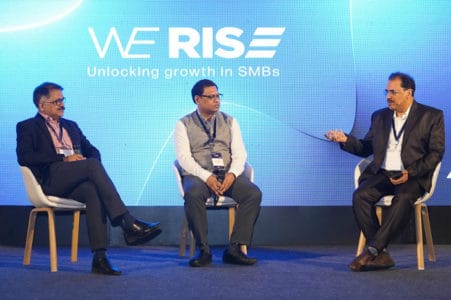– By B. Swaminathan
Industry 4.0, or the Fourth Industrial Revolution, has brought significant changes to traditional manufacturing practices, using disruptive technologies such as the industrial Internet of Things (IoT), artificial intelligence, big data analytics, and robotics to improve efficiency, quality, safety, and growth. In a chat with CMR, Sayeed Ahmed, the CEO of Biesse India, a subsidiary of Biesse SPA, shares his insights on how Industry 4.0 will transform the manufacturing sector in India.
Q1. How latest technologies are delivering value across every area of the factory
Ans. The digitally enabled factory of today looks very different from the leading factories of ten years ago. Manufacturers can choose from hundreds of different solutions and technological applications to enhance their working processes- thanks to advancements in data and analytics, AI, and ML, as well as the array of technology vendors in the market.
When used effectively, these solutions can produce substantial returns. In a wide range of sectors, it is not unusual to observe improvements such as a 10 to 30% increase in throughput, 30 to 50% decrease in machine downtime, 15 to 30% increase in labor productivity, and 85% improvement in forecasting accuracy.
Q2. How global organizations are embracing Industry 4.0?
Ans. Over the past five years, a select group of companies have pulled ahead in their efforts to implement Industry 4.0 across their manufacturing networks. Leading manufacturers are now realizing significant value from data and analytics, AI, and machine learning (ML). Companies like Seat, Siemens, and Airbus have become international benchmarks for Industry 4.0 by implementing artificial intelligence, virtual reality, collaborative robots, and big data solutions in their factories for several years. This has allowed these companies to become more efficient and flexible.
Q3. What is your view of Industry 4.0 in India?
Ans. In Indian manufacturing, Industry 4.0 has reached a tipping point, with more than two-thirds of Indian businesses embracing digital transformation by 2025, contributing to a 25% increase in India’s manufacturing GDP. The Indian industry has begun transitioning to digitalization, with USD 5.5 billion to 6.5 billion invested in Industry 4.0 in FY21. The industry spends 50% of its budget on core technologies like cloud and IoT. Currently, 35-40% of businesses are in the proof-of-concept stage and will need to move quickly from Proof-of-Concept (PoC) production. Over the next 18-24 months, businesses intend to increase their investments in network technology, big data analytics, central and remote-controlled monitoring, and automation. India is actively evolving to keep up with the rapid advancements.
The Government of India has already established an enabling policy framework and incentives for infrastructure development based on a PPP (Public-Private Partnership) model. The National Institute of Technology Aayog is the authorized nodal organization for interacting with the World Economic Forum to develop new policy frameworks for emerging technologies. Bharat 4.0 (Smart Advanced Manufacturing and Rapid Transformation Hubs) is a program of the Department of Heavy Industries that promotes Industry 4.0 implementation. The program aspires to spread technical solutions to Indian manufacturing units by 2025 through initiatives such as awareness campaigns, training, and demonstration centers.
Q5. Do you think Indian SMEs could afford industry 4.0?
Ans. As per a recent NASSCOM report, the Indian manufacturing industry spent between $5.5 to $6.5 bn on Industry 4.0 solutions in the 2020-21 fiscal year. Government regulations and private sector investments are pushing Indian manufacturing to adopt digital technology, with the goal of contributing 25% to the GDP by FY26.
Currently, MSMEs account for 33% of manufacturing GVA and 45-50% of exports in India, yet they face scale, funding, and leadership issues when it comes to digital adoption. Cloud, IoT, Big Data Analytics, Connectivity Tech, and RPA are being invested in by MSMEs, while a few manufacturers are experimenting with single/multi-site dark manufacturing platforms.
The Indian manufacturing sector is being integrated into the plans for Industry 4.0, as it plans to develop smart factories. This gives the manufacturing industry excellent potential to enter the fourth industrial revolution. Embedded software, advanced sensors, and collaborative robots herald the era of smart manufacturing. Factories and warehouses are implementing industry 4.0 solutions to digitize and automate industrial operations, reduce equipment downtime, and make factories more flexible, efficient, and productive.
The Boeing Company has invested in India’s first smart factory, which is being created at the Product Design and Manufacturing (CPDM) Centre of the Indian Institute of Science (IISc) Bangalore. Various Indian organizations are expanding their focus on developing new IoT and M2M solutions and collaborating with other companies. The Government of India’s Digital India strategy is expected to boost the focus on IoT in solving local concerns.
Q6. What are the trends you predict in the future for India in adopting new techs?
Ans. To truly usher in the fourth industrial revolution, Indian businesses need to adapt to the rapidly changing technological world. The government must incentivize technological investments, boost R&D, improve human capital, expand institutional capacity, and create a social safety net. These four elements, if used successfully, might speed India’s industrialization.
Smart manufacturing technologies have the potential to boost India’s long-term competitiveness and sustainability as it strives to become a global manufacturing hub. The potential is huge and Prime Minister Narendra Modi has given a major boost to the manufacturing industry with the ‘Make in India’ initiative. The Industry 4.0 movement will accelerate even further with the right demand, skilled labor, and a government that supports these initiatives.













